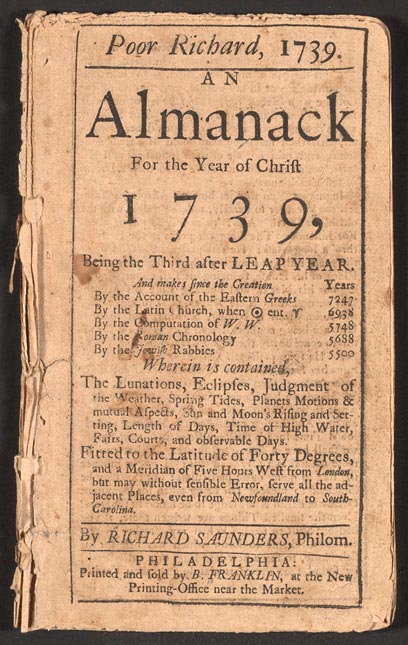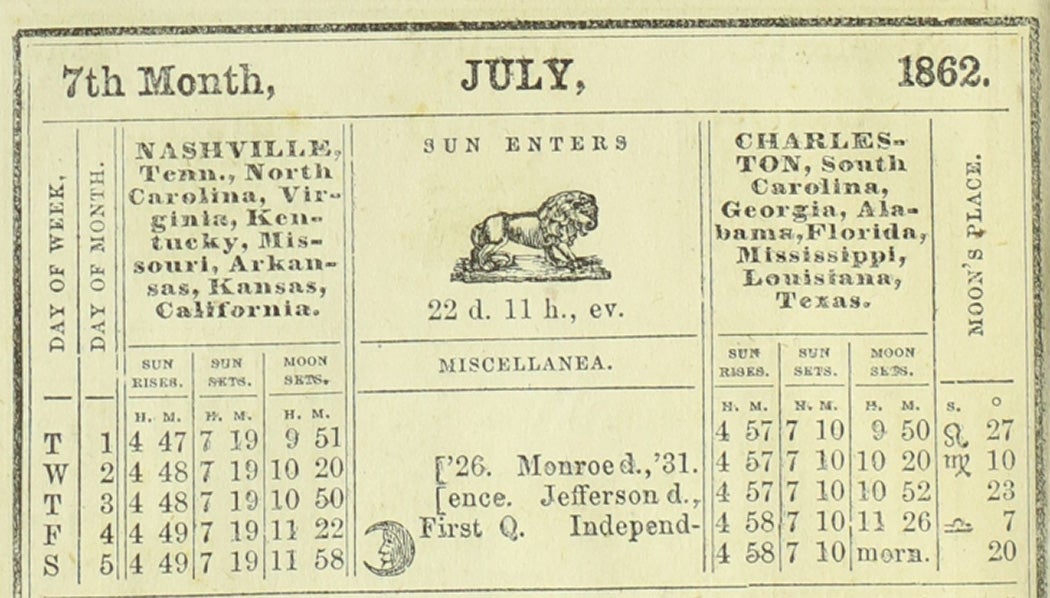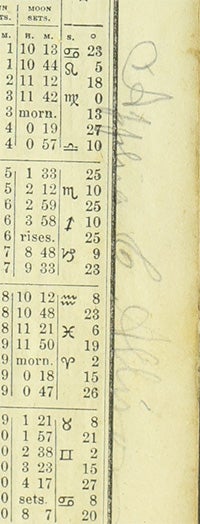The most famous of American almanacs, Benjamin Franklin’s Poor Richard’s Almanack, which was published annually from 1732 to 1758, begins each edition by invoking its year’s distance from both the birth of Christ and the year of Creation as calculated by varying ancient cultures. While it was common for almanacs to employ this device to, for instance, mark the year’s distance from the beginning of a monarch’s reign, Franklin’s title page features an unusual onslaught of numbers. These figures situate the almanac’s colonial American readership within both an international and interdenominational context (differing creation dates are given for the Eastern Greeks, the Latin Church, the Roman Chronology, and the Jews). The table of calculations also prepares the almanac’s reader for the onslaught of data to come, comprising “Lunations, Eclipses, Judgment of the Weather, Spring Tides, Planets Motions and Mutual Aspects, Sun and Moon’s Rising and Setting, Length of Days, Time of High Water, Fairs, Courts, and observable days.” But it also acknowledges that numbers and calculations are only as concrete as the cultures that create them.
Just over a century after Franklin published his last issue of Poor Richard’s, almanacs continued to enjoy massive popularity in the United States. Yet the nation that Franklin had helped to forge, ideologically and diplomatically, was under threat of dissolution. An 1862 almanac published in Nashville, Tennessee, employs calculations on its title page to very different ends than Franklin. It states it will cover “the year of our lord 1862—being the second after bissextile, or leap year, the eighty-sixth of American Independence, and the second of the Confederate States.” This slight book, organized and prepared in the first year of the Civil War, employs strategies like numeracy and astrological knowledge used by earlier movements, including Protestant religious groups and, ironically, abolitionists, to legitimize rhetorically the Confederacy as a nation with God-granted sovereignty—with both a past and an inevitable future.

In 1861, at the time of the Confederacy’s fledgling nationhood, almanacs were an established print genre, with a rich history that dated back hundreds if not thousands of years. The Babylonian Almanac, for example, lists each day of the year with a prediction for good or bad events, while the Alexandrian polymath Ptolemy wrote his Phaesis to record star rising and setting dates alongside weather predictions. With the advent of print, almanacs became more accessible and more popular. The first printed English almanac, Richard Pynson’s Kalender of Shepherdes, appeared around the year 1500; by the seventeenth century, the genre entered its “golden age,” with many sources claiming almanacs to be the second most-popular type of book—after only the Bible.
Weekly Newsletter
As the English established colonies in North America, they of course brought almanacs with them, and soon colonial publishers like Franklin and his brother James were producing almanacs for New England’s farmers. These included not only much-appreciated information on weather and astronomy but also the folksy aphorisms for which Poor Richard’s became famed. Other eighteenth-century almanacs went beyond astronomical and meteorological predictions to include information such as lists of government officials, important historical dates, and recipes, in a competition to become ever more useful.
The golden age of almanacs coincided with the birth and formative years of the United States of America, and we can see in texts like Andrew Ellicott’s The United States Almanac (first published in 1782) how the genre could be used to substantiate the new nation’s legitimacy. Ellicott directly connected the data collected in his almanac with US independence in a letter he wrote to then-president Thomas Jefferson calling for longitude calculations to be reckoned “from our own Capitol, and not from a place within another country” (i.e., Greenwich, in London). Ellicott viewed this reliance on British calculations as one of “a number of small ligaments, which tho apparently unimportant, are nevertheless a drawback upon that absolute independence we ought as a nation to maintain.”
Exactly sixty years later, the editors of the Nashville Confederate almanac would use a similar strategy to represent their own “absolute independence” from the Union. Its title page attests that its calculations were “made at the University of Alabama,” and the data it provides on timings like sunrise and sunset are divided into two geographical groupings: Nashville, Tennessee, and Charleston, South Carolina. It’s interesting to note that the Nashville timings were also said to pertain to North Carolina, Virginia, Kentucky, Missouri, Arkansas, Kansas, and California, while the Charleston timings also applied for Georgia, Alabama, Florida, Mississippi, Louisiana, and Texas. These groupings have obvious scientific flaws (how can the sun rise at the same time in Tennessee and California?), and they also point to areas of divided loyalty like Kentucky, Kansas, Missouri, and California that troubled the ideological boundaries of the Confederacy.
Despite these difficulties and inconsistencies, the 1862 almanac yokes numerical data to the geographical span, actual and potential, of the CSA to assert its nationhood. The timings of the moon’s phases, for example, are given for Nashville, Charleston, New Orleans, and San Francisco—with the last city included, perhaps, in the hope that California’s Southern transplants and sympathizers might succeed in encouraging the young state to join the Confederacy. The deluge of numbers provided by the almanac includes not only astronomical data, but also dates in history. Thus for July 4, we learn, for example, not only the sunrise, sunset, and moonrise times for both Nashville and Charleston, but also the following “miscellanea”: “First Q [First Quarter Moon]. Independence. Jefferson d., ’26. Monroe d., ’31.” Among these miscellanea are various key moments from the first year of the war: for June 1, “Battle of Aquia Creek begun, 1861;” for April 18, “Davis inaug., 1861;” for September 21, “St. Matthew. Lexington, Mo., captured, 1861.”

In these “miscellanea” authors turn immediate history—events that had taken place in the same year in which the book was being set and prepared for publication—into a legitimized form of national history, placed alongside other dates and names like Richard Henry Lee, Henry Clay, Jefferson, and Monroe—American Founding Fathers and politicians who were also Southerners and slave owners. By claiming the parts of US history that championed states’ rights and the perpetuation of slavery, and by aligning the events of its own brief existence as a self-declared new nation with these carefully chosen earlier moments from American history, the writers of the 1862 almanac sought to write the Confederacy into being.
The almanac’s religious material further underscored this legitimacy: September 21 is not just the date of the capture of Lexington, as we’ve seen, but also of the Feast of St. Matthew. Although the almanac’s astrological readings and predictions may strike modern readers as occult or heretical, early Americans would have had no difficulty reconciling the two different systems of knowledge. For Protestants in early America, as T.J. Tomlin has argued and JSTOR Daily has previously covered, astronomy and astrology were equally ordained by God; there was no paradox involved in an almanac published by a Christian publishing house. Among the useful information provided by the text is not just the members of the Confederate government, but also the publishing interests of the “M.E. Church, South;” members of the Methodist missionary society; locations of conferences and collections raised; and so on.
By weaving this ecclesiastical information into the yearly calendar and an account of significant dates, the almanac’s editor, Thomas Osmond Summers, asks readers to understand the Confederacy as a nation both natural and historical. Summers was an English-born popular Methodist preacher and publisher who is believed to have written or edited at least 500 books on various topics and to have transformed Methodist liturgy. His 1862 almanac echoes the rhetoric of countless sermons that would have been preached throughout the South at the same time emphasizing the Confederacy’s God-granted sovereignty. A North Carolina sermon preached by Thomas Atkinson in late spring of 1861, for instance, compared the war with a “cloud we have all been so long watching” that “is now beginning to burst upon us.”
“It seems to me,” Atkinson continued, “that no one but an Atheist, or an Epicurean, can doubt that it is God who rides in this storm, and will direct the whirlwind.” The almanac, too, turns a human-driven conflict into an act of God. It promises its readers they can know the future that God has planned, both in terms of weather and war.
* * *
The 1862 almanac produced by the Southern Methodist Publishing House is exemplary of the varying scales of time and types of knowledge harnessed by the genre, but it was far from the only almanac published for an explicitly Confederate audience. While all almanacs of the era provided weather predictions and astrological information for a given year, each publishing house’s version had its own inclusions and emphases. There were almanacs published specifically for Southern soldiers that featured short, uplifting Christian stories alongside inspirational poems of the Chicken Soup for the Soul variety.
Others, like H.C. Clarke’s 1863 Confederate Household Almanac published in Vicksburg, Mississippi, were geared toward the women left behind by war and included recipes that acknowledge the lack of goods and foodstuffs across the South. These include how to make “Confederate dye” from elderberries; a variety of breads from rice flour; and “mutton suet candles, in imitation of wax.” The Southern Almanac of 1863 from Lynchburg, Virginia, meanwhile, took a page from Franklin’s book and included several jokey anecdotes relating to the war, including the following:
 Newspapers of the time included similar material, but they lacked the almanac’s promise of a legible future for the Confederacy. We can sense this potential future in the marginalia of the digitized copy of the Nashville almanac, which helps us to identify one of its owners. The name “Apphia C. Allison” is scrawled multiple times across its pages. According to genealogical records, Allison was born in Tennessee in December 1854, the youngest of Robert Allison and Mary Chester’s many children; she would have been around seven years old in 1862. For a child living in an uncertain time and dealing with the hardships of war, the almanac must have provided entertainment, knowledge, and comfort (as well as providing a place to record, touchingly, the exact date when someone shot her dog).
Newspapers of the time included similar material, but they lacked the almanac’s promise of a legible future for the Confederacy. We can sense this potential future in the marginalia of the digitized copy of the Nashville almanac, which helps us to identify one of its owners. The name “Apphia C. Allison” is scrawled multiple times across its pages. According to genealogical records, Allison was born in Tennessee in December 1854, the youngest of Robert Allison and Mary Chester’s many children; she would have been around seven years old in 1862. For a child living in an uncertain time and dealing with the hardships of war, the almanac must have provided entertainment, knowledge, and comfort (as well as providing a place to record, touchingly, the exact date when someone shot her dog).
Yet the futures promised by Confederate almanacs were, of course, not to come. A Union almanac of the Civil War era helps demonstrate why the Confederate cause would soon become the Lost Cause. The National Almanac and Annual Record for 1863, produced by Philadelphia publisher George W. Childs (who also boasted publishing houses in London, Paris, and San Francisco), clocked in at a whopping 698 pages and contained a deluge of numerical data, including a full accounting of the finances of the United States as well as data for individual states. Childs pointedly includes the “disloyal” states in his calculations, while admitting that their disloyalty made the collection of accurate data difficult. This refusal to ignore or separate out the states in rebellion shows how powerful the preservation of Union was as a rhetorical rallying cry for the North, particularly in the war’s first two years.
In addition to establishing the North’s determination to preserve the Union, Childs’ almanac includes a chart displaying the Confederacy’s fundamental flaw in numerical terms: the institution of slavery. Slavery is virtually nonexistent in Southern almanacs, but Childs brings its economic and moral impact on the South to the fore in his chart titled “Valuation of Real and Personal Property in the Loyal Free States; in the Loyal Slave States; in the Rebel States; and in the Aggregate… .” Comparing Census data from 1850 and 1860, Childs deducts the value of enslaved people from the property totals for states that allowed slavery, “[slaves] being treated here as producers and consumers of wealth.” In this straightforward phrase, Childs transforms enslaved people from property to human beings. He also demonstrates, using sheer numbers, how much the Union outmanned and out-resourced the Confederacy, particularly after enslaved people were removed from the property evaluations of rebel states; less the value of slaves, people in rebel states owned $380 per person, versus $477 per person in loyal states. In effect, Childs’ almanac makes the pragmatic case for emancipation through numbers in a way that parallels the rhetorical case for emancipation made by President Lincoln in the same year.
After the Civil War, almanacs continued to be published (as they are to this day). But in the US, the war period marked a turning point in the popularity of the genre. Increasingly people turned to newspapers and magazines for information as technologies like the telegraph and the railroad, alongside cheaper and easier printing, made up-to-date news ever more accessible. At the same time, and also thanks to the telegraph, weather predictions were becoming more reliable. The same year that the American Civil War started, Robert FitzRoy published the first weather forecast in Great Britain; the US would have to wait until after the war’s conclusion before it could establish the foundations of its own National Weather Service, which was signed into law by president and former Union general Ulysses S. Grant in 1870. Predicting the weather was no longer a matter of reading God’s will through the stars, a task that any layperson could participate in (with the help of almanac publishers). Instead, it became increasingly a matter of gathering and interpreting scientific data that could only be attempted by professionally trained meteorologists. The almanacs of the American Civil War capture a particular moment of instability within the national consciousness; Confederate almanacs, in particular, record the attempts of a fledgling “nation” to justify and codify its own existence. That these attempts would ultimately fail were written not just in the stars, but in the very institutions upon which the Confederacy staked its claim to nationhood.
Support JSTOR Daily! Join our membership program on Patreon today.







